Pumpkin Ravioli: A Rich and Flavorful Pasta Dish
Can homemade pasta truly compete with restaurant-quality dishes when it comes to capturing the essence of autumn in a single, luxurious bite? The answer reveals itself through the art of crafting pumpkin ravioli, a sophisticated pasta creation that transforms humble seasonal ingredients into an extraordinary culinary experience. This main dish recipe elevates the traditional concept of stuffed pasta by combining silky-smooth pumpkin filling with tender handmade pasta pillows, creating a harmonious balance of flavors that celebrates the richness of fall harvest.
The versatility of pumpkin ravioli extends beyond its autumn associations. While naturally suited for cozy fall dinners and holiday gatherings, this elegant pasta dish adapts beautifully to formal dinner parties, romantic meals, or casual family suppers. The filling’s creamy texture and subtle sweetness pair exceptionally well with various sauce options, from classic brown butter and sage to rich cream reductions or light olive oil preparations. Each variation offers a unique interpretation while maintaining the pumpkin ravioli dish’s fundamental character and appeal.
Table of Contents
Ingredients List
For this pumpkin ravioli recipe, you’ll need carefully selected ingredients that work in harmony to create pasta perfection:
For the Fresh Pasta Dough:
- 2 cups all-purpose flour
- 3 large eggs
- 1 tablespoon extra virgin olive oil
- 1/2 teaspoon fine sea salt
- 2-3 tablespoons warm water
For the Pumpkin Filling:
- 2 cups roasted pumpkin puree
- 1/2 cup whole milk ricotta cheese
- 1/4 cup freshly grated Parmigiano-Reggiano cheese
- 1 large egg yolk
- 1/4 teaspoon freshly grated nutmeg
- 1/2 teaspoon ground cinnamon
- 1 teaspoon fine sea salt
- 1/4 teaspoon white pepper)
- 2 tablespoons fresh sage leaves, minced
For Assembly and Serving:
- 1 large egg, beaten (for sealing ravioli edges)
- Semolina flour for dusting (prevents sticking during preparation)
- 4 tablespoons unsalted butter (for classic brown butter sauce)
- 8-10 fresh sage leaves (for garnish and flavor)
- Additional Parmigiano-Reggiano for serving
Timing of the Pumpkin Ravioli Dish
This pumpkin ravioli recipe requires patience and attention to detail for optimal results:
- Pasta dough preparation: 20 minutes active, 30 minutes resting
- Pumpkin filling preparation: 15 minutes (if using pre-roasted pumpkin)
- Fresh pumpkin roasting: 45-60 minutes (if starting from scratch)
- Rolling and cutting pasta: 30-40 minutes
- Assembling ravioli: 45-60 minutes (depending on experience level)
- Cooking time: 4-6 minutes per batch
- Total active time: 2-2.5 hours
- Total time: 3-3.5 hours (including resting periods)
Step-by-Step Instructions
Step 1: Create the Perfect Pasta Dough Foundation
Begin by creating a flour well on a clean work surface or in a large mixing bowl. Crack eggs into the center, add olive oil and salt, then use a fork to gradually incorporate flour from the inner edges. This traditional method, called the fountain technique, ensures even hydration and prevents the eggs from escaping before incorporation. Continue mixing until a shaggy dough forms, then knead vigorously for 8-10 minutes until the dough becomes smooth, elastic, and slightly tacky. The finished dough should spring back when poked gently with your finger.
Step 2: Rest the Dough for Optimal Texture Development
Wrap the kneaded dough tightly in plastic wrap and let it rest at room temperature for at least 30 minutes, though up to 2 hours is even better. This resting period allows gluten to relax, making the dough much easier to roll thin without tearing. During this time, the flour continues to hydrate fully, resulting in silkier pasta with better texture and easier handling.
Step 3: Prepare the Luxurious Pumpkin Filling
In a large mixing bowl, combine roasted pumpkin puree, ricotta cheese, Parmigiano-Reggiano, and egg yolk. Mix until completely smooth and uniform in color. Add nutmeg, cinnamon, salt, white pepper, and minced sage, stirring until evenly distributed. Taste and adjust seasoning as needed – the filling should be flavorful enough to shine through the pasta wrapper. The consistency should be thick enough to hold its shape when spooned but smooth enough to pipe or dollop easily.
Step 4: Roll the Pasta to Perfect Thinness
Divide rested dough into 4 equal portions, keeping unused portions covered to prevent drying. Using a pasta machine or rolling pin, roll each portion into thin sheets. For pasta machines, gradually decrease settings until reaching the second-to-thinnest setting (usually setting 6 or 7). The pasta should be thin enough to see your hand through it but not so thin that it tears easily. Dust lightly with semolina flour as needed to prevent sticking.
Step 5: Cut and Prepare Pasta Sheets for Filling
Cut rolled pasta sheets into workable rectangles, approximately 12 inches long. Lay sheets on a lightly floured surface and brush one sheet lightly with beaten egg wash. This egg wash acts as glue, ensuring proper sealing and preventing ravioli from opening during cooking. Work with one sheet at a time to prevent the pasta from drying out.
Step 6: Portion and Place the Pumpkin Filling
Using a piping bag, small spoon, or cookie scoop, place rounded teaspoons of pumpkin filling along one half of the pasta sheet, spacing them about 2 inches apart. Avoid overfilling, as this can cause the ravioli to burst during cooking. Each portion should be generous enough to taste in every bite but small enough to seal properly around the edges.
Step 7: Form and Seal the Ravioli Parcels
Carefully fold the unfilled half of the pasta sheet over the filling, aligning edges precisely. Starting from the folded edge, gently press around each mound of filling to remove air pockets, which can cause ravioli to float or cook unevenly. Use your fingers or a fork to press and seal edges firmly, ensuring no filling escapes. Cut between each ravioli using a fluted pasta wheel or sharp knife, leaving about 1/2 inch border around the filling.
Step 8: Final Shaping and Quality Check
Place finished ravioli on semolina-dusted baking sheets, ensuring they don’t touch each other to prevent sticking. Check each piece for proper sealing, pressing edges again if necessary. Well-made ravioli should feel plump and secure, with no visible gaps in the seams. Cover with clean kitchen towels if not cooking immediately.
Step 9: Cook to Perfection in Well-Salted Water
Bring a large pot of water to a rolling boil and add generous salt (the water should taste like the sea). Carefully add ravioli in batches to avoid overcrowding, which can cause them to stick together. Fresh ravioli cook quickly, typically 3-4 minutes for al dente texture. They’re done when they float to the surface and feel tender but still have slight firmness when gently pressed.
Step 10: Finish with Classic Brown Butter Sage Sauce
While ravioli cook, prepare the classic accompaniment by melting butter in a large skillet over medium heat. Add sage leaves and cook until butter turns golden brown and smells nutty, about 2-3 minutes. Remove from heat and carefully add a splash of pasta cooking water to prevent further browning. Gently toss drained ravioli in the brown butter sauce, coating each piece evenly.
Nutritional Information of the Pumpkin Ravioli
For a serving of this pumpkin ravioli recipe (6-7 pieces per serving):
- Calories: 385-420
- Protein: 16-18g
- Carbohydrates: 52-58g
- Dietary Fiber: 3-4g
- Total Fat: 14-16g
- Saturated Fat: 7-8g
- Cholesterol: 165-180mg
- Sodium: 580-650mg
- Potassium: 420-480mg
- Vitamin A: 12,000-15,000 IU
- Vitamin C: 8-12mg
- Calcium: 180-220mg
- Iron: 3-4mg
- Folate: 85-95mcg
- Beta-carotene: 7,000-9,000 mcg
Healthier Alternatives for the Pumpkin Ravioli Recipe
Transform your pumpkin ravioli into a healthier version with these modifications:
- Whole wheat pasta option: Replace all-purpose flour with whole wheat pastry flour for increased fiber and nutrients while maintaining workable texture
- Reduced-fat filling: Use part-skim ricotta and reduce cheese quantities by half, compensating with additional roasted vegetables like carrots or parsnips
- Gluten-free adaptation: Substitute pasta flour with a high-quality gluten-free flour blend specifically formulated for pasta making
- Vegan transformation: Replace egg pasta with semolina-water dough and use cashew-based ricotta or silken tofu in the filling
- Lower-sodium version: Reduce added salt and compensate with fresh herbs, lemon zest, and aromatic spices like sage and thyme
- Protein enhancement: Add finely chopped toasted walnuts or pine nuts to the filling for healthy fats and additional protein
- Vegetable boost: Incorporate finely diced roasted vegetables like butternut squash, sweet potato, or carrots to increase nutrient density
- Lighter sauce alternatives: Serve with simple olive oil and herb dressing instead of butter-based sauces to reduce saturated fat content
Serving Suggestions
Elevate your pumpkin ravioli experience with these ideas:
- Serve in wide, shallow bowls with a drizzle of high-quality extra virgin olive oil and freshly cracked black pepper for elegant simplicity
- Create an autumn harvest presentation by garnishing with toasted pumpkin seeds, dried cranberries, and microgreens for textural contrast
- Pair with a light arugula salad dressed with lemon vinaigrette to balance the richness and add fresh, peppery notes
- Offer alongside crusty artisan bread and herb-infused olive oil for dipping to complete the Italian dining experience
- Present as part of a multi-course Italian meal, preceded by antipasti and followed by a simple dessert like panna cotta
- Complement with a glass of medium-bodied white wine such as Chardonnay or Pinot Grigio to enhance the delicate flavors
- Garnish with crispy fried sage leaves and a light dusting of aged Parmigiano-Reggiano for restaurant-quality presentation
- Serve family-style in a large, warmed serving bowl to encourage sharing and create a convivial dining atmosphere
Common Mistakes to Avoid
Master this pumpkin ravioli recipe by avoiding these pitfalls:
- Overfilling the ravioli parcels: Excessive filling causes bursting during cooking and makes sealing nearly impossible, resulting in disappointing presentation
- Insufficient pasta dough resting: Skipping or shortening the resting period creates tough, elastic dough that’s difficult to roll and tears easily
- Using wet or watery pumpkin puree: Excess moisture in filling creates soggy pasta and prevents proper sealing, leading to opened ravioli during cooking
- Inadequate edge sealing: Poorly sealed edges allow filling to escape during cooking, creating cloudy cooking water and disappointing results
- Rolling pasta too thick or too thin: Thick pasta overwhelms delicate filling, while overly thin pasta tears and doesn’t hold filling properly
- Overcrowding during cooking: Too many ravioli in the pot causes sticking, uneven cooking, and potential breakage from collision
Storing Tips for the Pumpkin Ravioli Recipe
Preserve the freshness of your pumpkin ravioli with these strategies:
- Short-term refrigeration: Store uncooked ravioli on semolina-dusted trays, covered with clean kitchen towels, for up to 24 hours
- Freezing for later use: Place assembled ravioli on parchment-lined baking sheets, freeze until solid, then transfer to freezer bags for up to 3 months
- Pasta dough storage: Wrap unused dough tightly in plastic wrap and refrigerate for up to 2 days or freeze for up to 1 month
- Filling preservation: Store prepared pumpkin filling in refrigerator for up to 3 days in airtight containers, bringing to room temperature before use
- Optimal freezing technique: Flash-freeze on trays before bagging to prevent clumping and maintain shape during long-term storage
- Proper thawing methods: Cook frozen ravioli directly from frozen, adding 1-2 minutes to cooking time for best texture and flavor
Conclusion
Pumpkin ravioli combines Italian pasta-making artistry with autumn’s finest flavors, creating an impressive dish that balances comfort and sophistication. This pumpkin ravioli recipe transforms simple ingredients into restaurant-quality results through careful technique and attention to detail, rewarding patience with extraordinary flavor and texture.
Try this pumpkin ravioli recipe and share your feedback in the review section or leave a comment about your experience with homemade pasta-making.
FAQs
Can I make pumpkin ravioli without a pasta machine? Yes, use a rolling pin to achieve thin, even sheets, though it requires more time and effort to reach proper thickness consistently.
How do I know when the ravioli are perfectly cooked? Fresh ravioli are done when they float to the surface and feel tender when gently pressed, typically 3-4 minutes in boiling water.
Can I prepare the filling in advance? Absolutely! The pumpkin filling can be made up to 3 days ahead and stored in the refrigerator, actually improving in flavor as ingredients meld.
What’s the best way to prevent ravioli from sticking together? Dust generously with semolina flour and ensure pieces don’t touch during storage, using parchment paper between layers if necessary.
What other sauces work well with pumpkin ravioli? Brown butter sage is classic, but cream sauce, olive oil with herbs, or simple marinara also complement the pumpkin filling beautifully.
Can I freeze assembled ravioli for later cooking? Yes, freeze on parchment-lined trays until solid, then store in freezer bags for up to 3 months, cooking directly from frozen.
Your Feedback Matters
There are no reviews yet. Be the first one to write one.

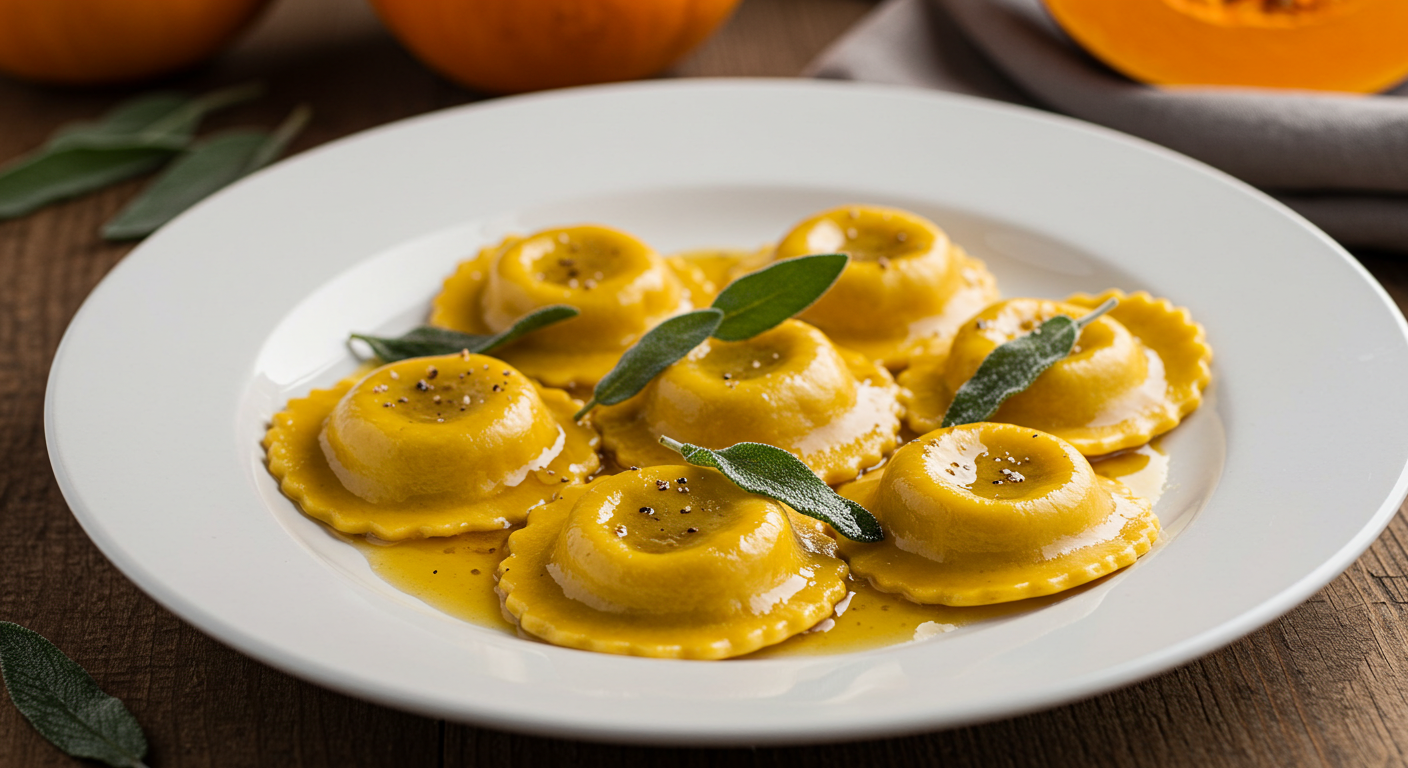
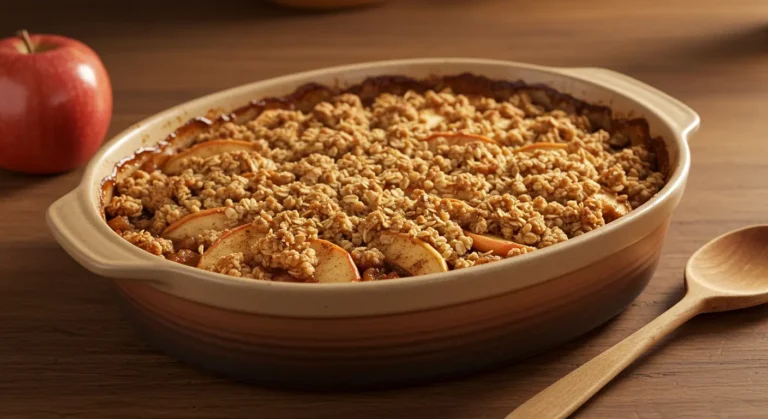
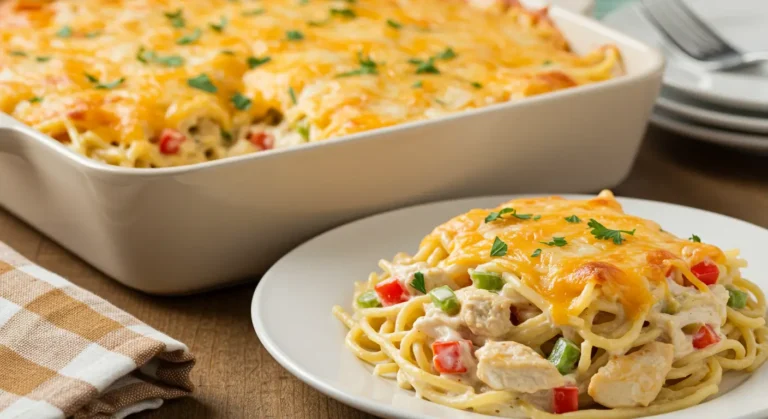
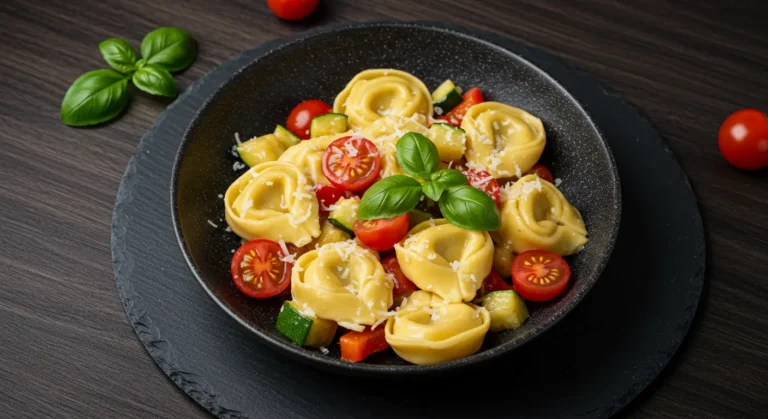
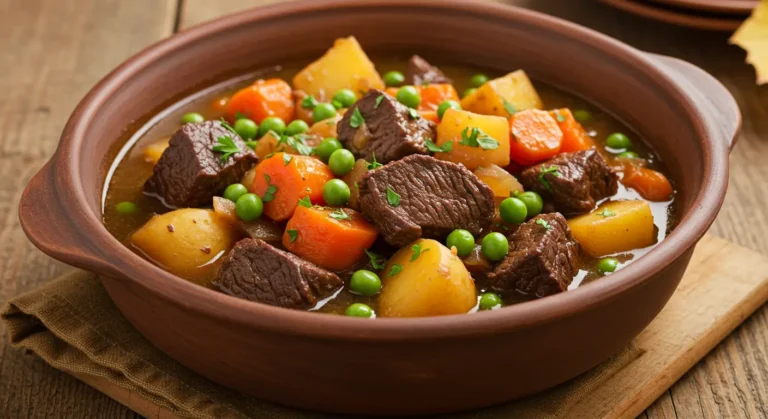
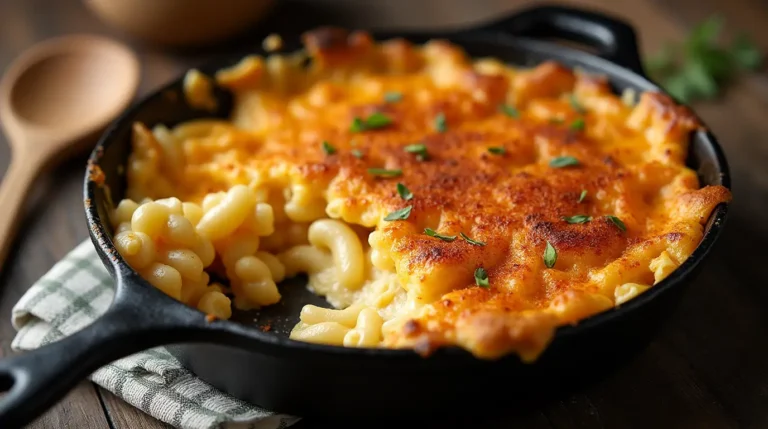
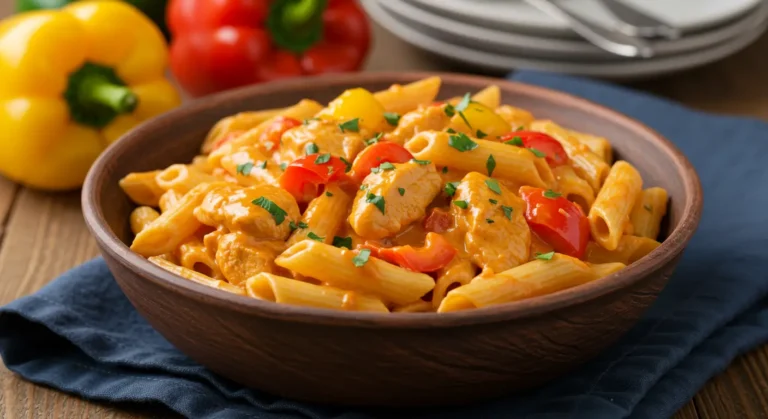
One Comment
Comments are closed.